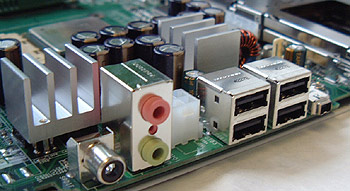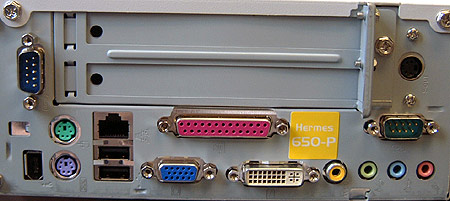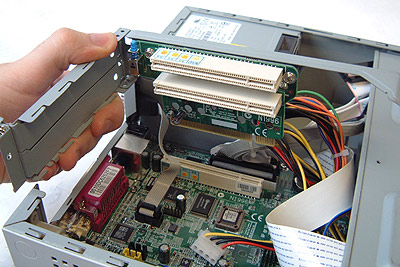 The MSI Hermes barebones PC is based on the custom designed MS-6535 motherboard
which uses the SiS650 Pentium 4 chipset.
The MSI Hermes barebones PC is based on the custom designed MS-6535 motherboard
which uses the SiS650 Pentium 4 chipset.
The motherboard supports Socket m478 processors
which runs on a 400 MHz FSB (Celeron or Pentium 4). With its two DIMM slots, the
motherboard can accommodate up to a maximum of 2GB of PC1600/2100 DDR RAM.
Because
of the relative small size of the
system, it's a given that most of the systems components are integrated into
the motherboard already so you don't need to worry too much about
expanding on the basic system.
The MS-6535 has 10/100 LAN, 5.1 audio, Memory Stick Reader, USB 2.0
and IEEE 1394. While the motherboard has both analog and DVI video outputs, the
system does not support
dual monitors. You can however hook up a TV via the TV/S-Video outputs while
using a regular computer monitor as well. Expanding the motherboard is a bit
more difficult but not impossible.

MSI
includes two PCI slots (via a riser card) as well as two PCMCIA slots at
the front. It was nice to see that installing longer PCI devices like the
SB Audigy is possible. While PCMCIA is not quite as useful as a full blown PCI
slot, they still do offer the end user quite a bit of flexibility as there are
many PCMCIA devices on the market, such as Wireless LAN adaptors.

Since MOSFETs generate quite a bit of heat, it was nice to see MSI went out
of their way to try and cool them with some passive aluminum
heatsinks. It would have been nice to find an AGP
port in the Hermes as well, but considering the size constraints it I don't think
this would have been very realistic, and besides the SiS chipset is not
really geared towards gaming systems. Tracking down a relatively new PCI videocard is a little
bit of a challenge, but not impossible. Even though the SiS650 Northbridge doesn't get very hot, I would have preferred to
see a larger passive heatsink on it.
Up next the benchmarks of what
should prove to be a pretty decent web and SOHO oriented computer.
